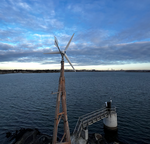New research provides clarity on fish spawning hotspots near offshore wind farms
A new study from the Offshore Renewables Joint industry Programme (ORJIP) funded by Vattenfall, innogy and SSE, led by the Carbon Trust and undertaken by GoBe Consultants, aimed to better understand the location of fish spawning sites in relation to offshore wind farms, and how these are considered within their consenting process.
Conditions to manage the effects of noise generated during the construction of offshore wind farms are already incorporated into the consenting process. These restrict construction activities during times when fish are considered to be most sensitive to disturbance, such as during spawning and migration.
The ‘Impacts on Fish from Piling at Offshore Wind Sites’ study, analysed annual fish spawning data in UK waters over the past 10 years to better define fish spawning grounds and to evaluate the potential impacts of new offshore wind sites on fish. The analysis shifts the focus of studies from abandoned spawning sites and highlights those regions that have shown recent spawning activity.
The main spawning sites for the different herring stocks in UK waters are well known. However, due to the specific habitat and environmental conditions that herring need to spawn successfully, there are discrete pockets of spawning bed areas that are less easy to identify as they can change from year to year. Currently the exact location of spawning beds can only be identified if they are recorded through grab sampling or by drop down video surveys.
As a result, offshore wind developers are affected by both precautionary noise modelling undertaken for environmental assessment, and by precautionary fish sensitivity maps. This means piling activity is often restricted due to limited information available on the actual level of impact risk associated with piling activities.
The techniques and methodology demonstrated in the ORJIP study provide clearer information of the areas of spawning and their proximity to offshore wind developments. If considered in the consenting process this could lead to a reduction in construction times, potentially lowering cost to consumers, and reducing operational disruption for offshore wind farms.
In a joint statement innogy, SSE & Vattenfall said: “This work helps offshore wind developers and regulators plan construction work with confidence and further establishes the importance of working together with subject experts on collaborative projects to progress scientific understanding.”
Eloise Burnett, Manager of ORJIP, the Carbon Trust, said: “This latest study adds to the considerable evidence base created through ORJIP to better inform future consenting. This study takes a rational look at the likely impacts of piling on spawning herring, and thus population effects in UK waters, employing heat-mapping techniques to produce clear outputs. This study comes at an important time. Consideration of the cumulative environmental impacts is important as The Crown Estate aims to lease new sites in UK waters in May 2019. ”
Dr Shaun Nicholson, Head of Strategic Marine Licensing, the Marine Management Organisation, said: “The ORJIP study enhances our knowledge of areas used by herring for spawning and improves the evidence base. This guidance should result in greater efficiencies in the consenting process and will help to minimise impacts to herring and thus contribute to our vision of sustainable use of our seas.“
Daniel Wood, Specialist Advisor, CEFAS, said: “This has been a really worthwhile study. It draws together the current evidence and thinking on the topic. The project highlights the challenges faced in working around herring spawning for developers, consultants, scientists and regulators. The project has helped collate and advance the science in this area.”
The study was supported by an expert panel with representatives from the Marine Management Organisation (MMO). International Council for the Exploration of the Sea (ICES), Centre for Environment, Fisheries and Aquaculture Science (CEFAS), Scottish Natural Heritage and Marine Scotland Science.
The full report can be accessed here.
- Source:
- Carbon Trust
- Author:
- Press Office
- Link:
- www.carbontrust.com/...
- Keywords:
- ORJIP, offshore, fish, UK, Carbon Trust, mapping, construction work, herring


























